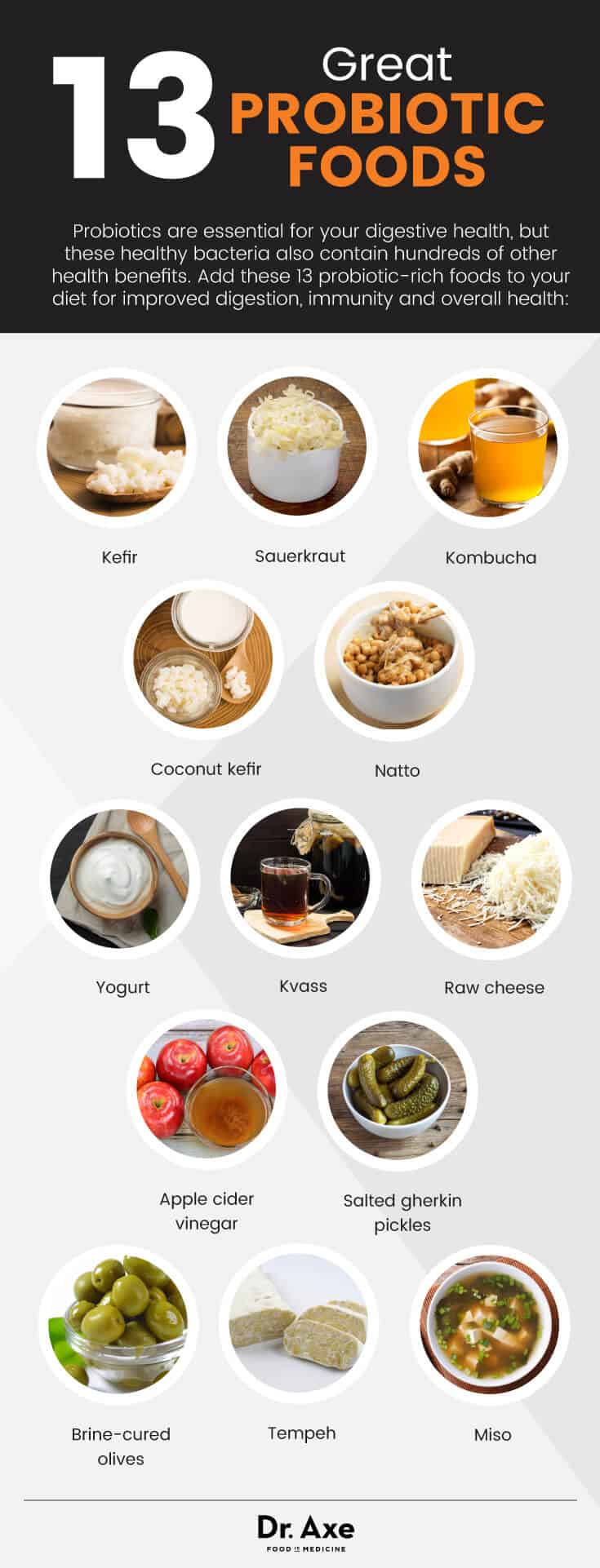
Are you getting enough probiotic-rich foods in your diet? Chances are you’re probably not. Probiotics are good bacteria that primarily line your gut and are responsible for nutrient absorption and supporting your immune system. (1)
FREE Guide: 13 Great Probiotic Foods You Should Be Eating
Probiotics are essential for your digestive health, but did you know there are hundreds of other health benefits of consuming probiotic-rich foods that you might not be aware of?
In this article, I want to cover the 13 probiotic foods you should consider adding to your diet today and how they can benefit you.
What Are Probiotics?
If you don’t have enough probiotics, the side effects can include: digestive disorders, skin issues, candida, autoimmune disease, and frequent colds and flus. (2) Historically, we had plenty of probiotics in our diet from eating fresh foods from good soil and by fermenting our foods to keep them from spoiling.
However, today because of refrigeration and dangerous agricultural practices like soaking our foods with chlorine, our food contains little to no probiotics and most foods today actually contain antibiotics that kill off the good bacteria in our bodies. (3)
By adding more probiotic foods into your diet, you could see all of the following health benefits (4, 5, 6):
- Stronger immune system
- Improved digestion
- Increased energy from production of vitamin B12
- Better breath because probiotics destroy candida
- Healthier skin, since probiotics improve eczema and psoriasis
- Reduced cold and flu
- Weight loss
Sound good? If you want all of these benefits, then it’s time to start consuming these probiotic foods for better health. In fact, you should eat a variety of types of probiotics as each one offers a different type of beneficial bacteria to help the body in a variety of ways.
7 Types of ‘Friendly’ Bacteria:
- Lactobacillus acidophilus
- Lactobacillus bulgarius
- Lactobacillus reuteri
- Streptococcus thermophilus
- Saccharomyces boulardii
- Bifidobacterium bifidum
- Bacillus subtilis
13 Great Probiotic Foods
1. Kefir – Similar to yogurt, this fermented dairy product is a unique combination of milk and fermented kefir grains. Kefir has been consumed for well over 3,000 years; the term kefir originated in Russia and Turkey and means “feeling good.” It has a slightly acidic and tart flavor and contains anywhere from 10 to 34 strains of probiotics. Kefir is similar to yogurt, but because it is fermented with yeast and more bacteria, the final product is higher in probiotics. (7)
2. Cultured Vegetables (Sauerkraut and Kimchi) – Made from fermented cabbage and other vegetables, sauerkraut is not diverse in probiotics but is high in organic acids, which give food its sour taste and support the growth of good bacteria. Sauerkraut is extremely popular in Germany today. Kimchi is a cousin to sauerkraut and is the Korean take on cultured veggies. Both of the fermented formulas are also high in enzymes, which can aid digestion. (8)
3. Kombucha – Is an effervescent fermentation of black tea that is started by using a SCOBY, also known as a symbiotic colony of bacteria and yeast. Kombucha has been around for over 2,000 years, originating around Japan. Many claims have been made about kombucha, but its primary health benefits include digestive support, increased energy and liver detoxification. (9)
4. Coconut Kefir – Made by fermenting the juice of young coconuts with kefir grains, this dairy-free option for kefir has some of the same probiotics as traditional dairy kefir but is typically not as high in probiotics. Still, it has several strains that are beneficial for your health. Coconut kefir has a great flavor, and you can add a bit of stevia, water and lime juice to it and make a great-tasting drink.
5. Natto – A popular dish in Japan consisting of fermented soybeans, natto contains the extremely powerful probiotic bacillus subtilis, which has been proven to bolster your immune system (10), support cardiovascular health (11) and enhance digestion of vitamin K2 (12). Also, Natto contains a powerful anti-inflammatory enzyme called nattokinase that has been proven to prevent blood clotting. (13)
6. Yogurt – Possibly the most popular probiotic food is live cultured yogurt or greek yogurt made from the milk of cows, goats or sheep. Yogurt in most cases can rank at the top of probiotic foods if it comes from grass-fed animals and has not been pasteurized. The problem is there is a large variation on the quality of yogurts on the market today. It is recommend when buying yogurt to look for three things: first, that it comes from goat’s or sheep’s milk, second, that it is grass-fed and third, that it is organic.

7. Kvass – Has been a common fermented beverage in Eastern Europe since ancient times. It was traditionally made by fermenting rye or barley, but in more recent years has been created using beets, fruit along with other root vegetables like carrots. Kvass uses lactobacilli probiotics and is known for its blood and liver-cleansing properties and has a mild sour flavor. (14)
8. Raw Cheese – Goat’s milk, sheep’s milk and A2 cow’s soft cheeses are particularly high in probiotics, including thermophillus, bifudus, bulgaricus and acidophilus. Always buy raw and unpasteurized cheeses if you want to receive any probiotics.
9. Apple cider vinegar – Great for controlling blood pressure, cholesterol (15), diabetes (16) and even weight loss (17), apple cider vinegar is a great daily addition that will bring many benefits — including providing probiotics. Drink a small bit each day or use it as a salad dressing.
10. Salted gherkin pickles – These fermented tasty treats are also a little recognized source of probiotics. Choose a smaller food manufacturer that uses organic products. If you can find a local maker, you’ll be getting some of the best probiotics for your health.
11. Brine-cured olives – Olives that are brine cured are an excellent source of probiotics too. Like with salted gherkin pickles, be sure to select a product that is organic first. Next, be certain that your olives aren’t made from a huge manufacturer. Choose a smaller company that advertises probiotics. Also make sure that your olives don’t contain sodium benzoate.
12. Tempeh – Hailing from Indonesia, this fermented soybean product is another source of probiotics. Tempeh is created by adding a tempeh starter to soybeans. The product is then left to sit for a day or two. The result is a cake-like product. (18)
You can eat tempeh raw or by boiling it and eating it with miso. It can also be used as a substitute for meat in a stir fry meal. Tempeh is commonly deep fried before eating, but, beware, this can greatly reduce its nutritional value.
13. Miso – Miso is a traditional Japanese spice found in many of their traditional foods. If you’ve ever been to a Japanese restaurant, you may have seen their miso soup.
It is created by fermenting soybean, barley or brown rice with koji. Koji is a fungus, and the fermentation process takes anywhere from a few days to a few years to complete. (19) Miso can be made into a soup, spread on crackers, in place of butter or just about anywhere you want.
If you want learn even more probiotics rich foods and the best probiotic supplements check out this article on Probiotic Benefits.
From the sound of it, you might think leaky gut only affects the digestive system, but in reality it can affect more. Because Leaky Gut is so common, and such an enigma, I’m offering a free webinar on all things leaky gut. Click here to learn more about the webinar.

Original article and pictures take draxe.com site
Комментариев нет:
Отправить комментарий